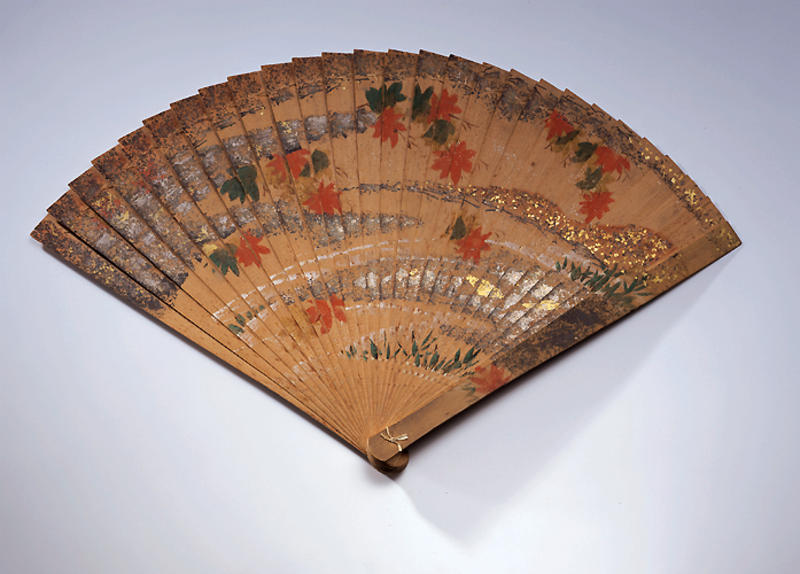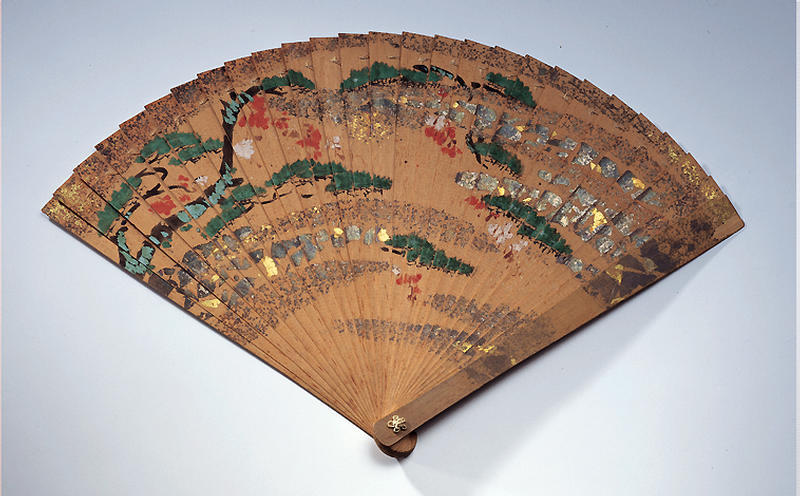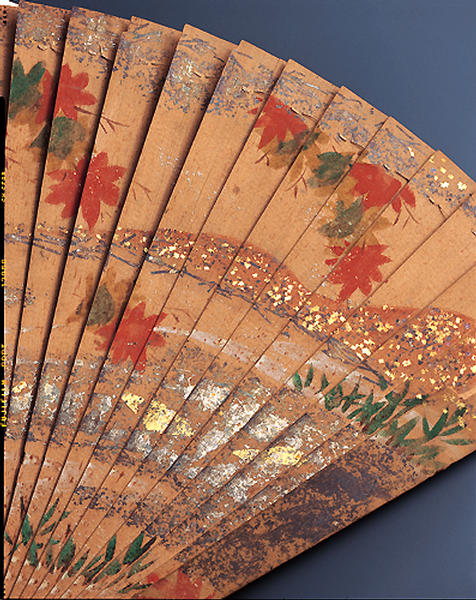檜扇
- 室町時代
- 14-15c
- 木製(桧)彩色
- H-40
- 所蔵
- 伝熊野速玉大社伝来
室町時代 14-15世紀
橋長:40.0cm
扇は,あおいで風を送る道具として,また公家の男女が正装のときに携えて威儀を糺すのにも用いる。この檜扇は,檜の薄板二十七枚を橋として構成され,末の方を絹糸で綴じ,要で留めて開閉ができるようにしている。
表裏ともに雲母を刷き,金銀切箔,野毛を散らして,たなびく雲や霞を表し,表面に松浜と紅白の花卉,裏面に紅葉と遠山の景の彩絵を施して,華やかな趣を呈している。綴じ紐に用いた白い絹糸は後補のものである。
なお,本品に彩絵の手法が酷似し,しかも大きさや橋の枚数が一致する檜扇として,熊野速玉大社(新宮市)に伝わる古神宝類中の事例がある。熊野速玉大社の神宝は,明徳元年(1390)の造替・遷宮にあわせて,三所神殿ほか十二社ならびに摂社の阿須賀神社のそれぞれに奉献されたもので,檜扇は都合十握が現存している。
それらと本品とを詳細に比較すると,神宝中の檜扇が,いずれも花鳥,樹木,風物などを,雲霞,山水などの背景のなかに比較的明瞭に描き込んでいるのに対し,本品ではその関係がやや散漫で,細部の表現にもあいまいさがある。
とはいえ,形式や趣が酷似しているという点では,速玉社古神宝との関係が最も深いとも思われ,両者の製作年代が大きく隔たるということはなかろう。(関根)
熊野神社熊野速玉大社(新宮)
熊野神社熊野速玉大社(新宮)
和歌山県新宮市新宮。
熊野川の河口にまつられる。「延喜式神名式」には熊野速玉大社という。
天平神護二年(766)には熊野早玉大社、式内大社。
「新抄格 勅符抄」には速玉社。
もと神倉山にまつられていたが、のちに阿須賀社の北にある現在地に移された(「熊野略記」)という。現在は第二殿の速玉宮(中御前)に、主神の熊野速玉大神をまつっている。
神倉山中腹には「ゴトビキ岩」という巨岩があり、おおくの祭祀遺物が発見されたことから、大和の三輪山同様、ここも神奈備山とみなされ、その山中のゴトビキ岩は磐座(いわくら)と観念されて、神まつりがおこなわれたと考えられている。なお、ゴトビキ岩は海上からも遠望できるという。
(図説日本の仏教6「神仏習合と修験」新潮社 平成元年刊所収の和田 氏著「熊野への道」より)
Catalogue Entry
Muromachi period, 14th to 15th centuries
Wood, color on surface
Length of spokes, 40.0cm
A folding fan is either used to fan oneself or is carried by men and women of the aristocracy as a symbol of their majesty. This cypress fan is made up of 27 thin sheets of cypress which have been bound together at the ends by silk cords, allowing the fan to be opened or shut as necessary.
The front and back surfaces of the fan are decorated with mica, cut gold and silver leaf, and thin strips of gold and silver leaf that form patterns of trailing clouds and mists. The front surface has a design of pine trees on a beach with red and white flowers, while the back shows a polychrome scene of autumn foliage and distant mountains, both scenes giving the fan an overall decorative appearance. The white silk cording presently used to bind the fan is a later addition.
In terms of its polychrome techniques and the size and number of spokes, this fan resembles an example transmitted as one of the shrine treasures at Kumano Hayatama Taisha. The treasures of the Kumano Hayatama Taisha (Shingu city) were presented to the three main shrine buildings, the 12 shrines, and the Asuka shrine, which is Kumano's affiliate shrine, upon the occasion of the construction of new shrines and the enshrinement of the deity forms in 1390 (Meitoku 1). 10 cypress fans are extant among these shrine treasures.
A detailed comparison of the present fan with these Kumano fans shows that the Kumano fans all depict birds and flowers, trees or scenery relatively clearly differentiated within a background of mist, clouds, and landscapes. This fan, on the other hand, reveals a more desultory handling of that balanced representation and a vaguer rendering of detail areas.
The close resemblance between the form and intent of the present fan with that of the Kumano fans indicates an extremely close relationship between the Kumano Shrine treasure fans and this fan, and there would not appear to be too great a difference in their date of production. SS


